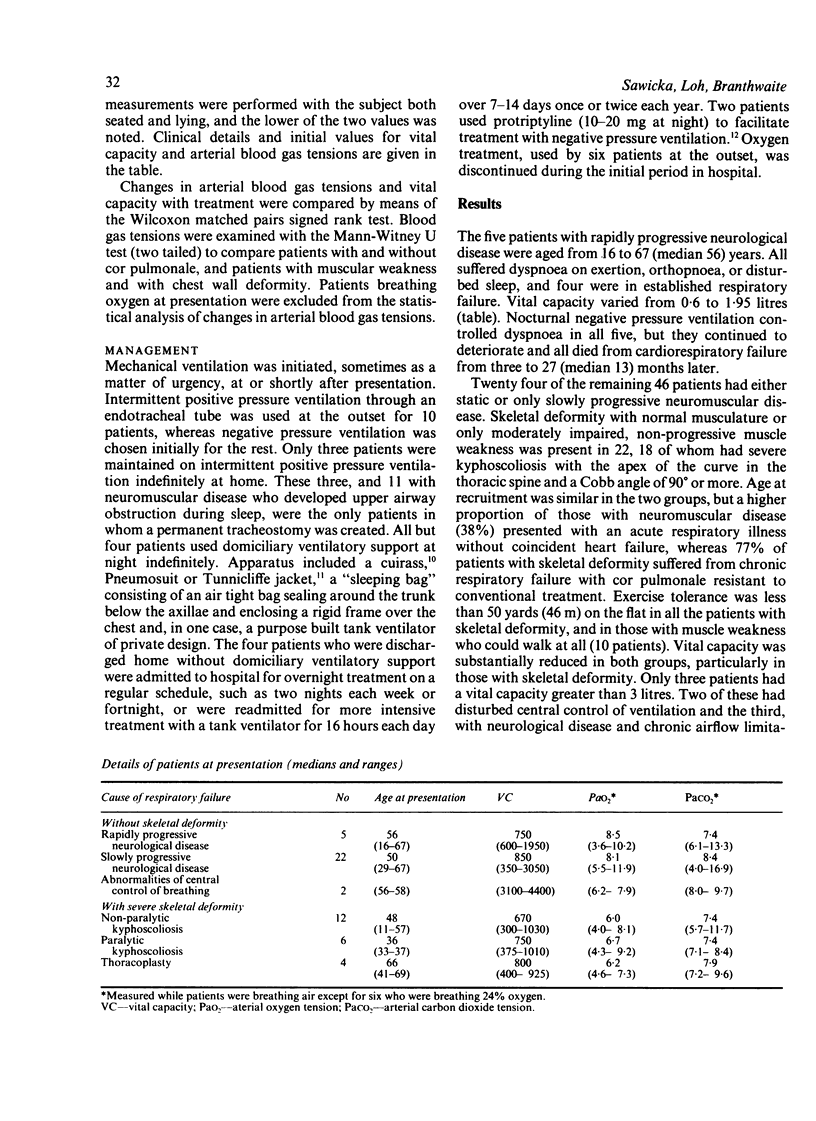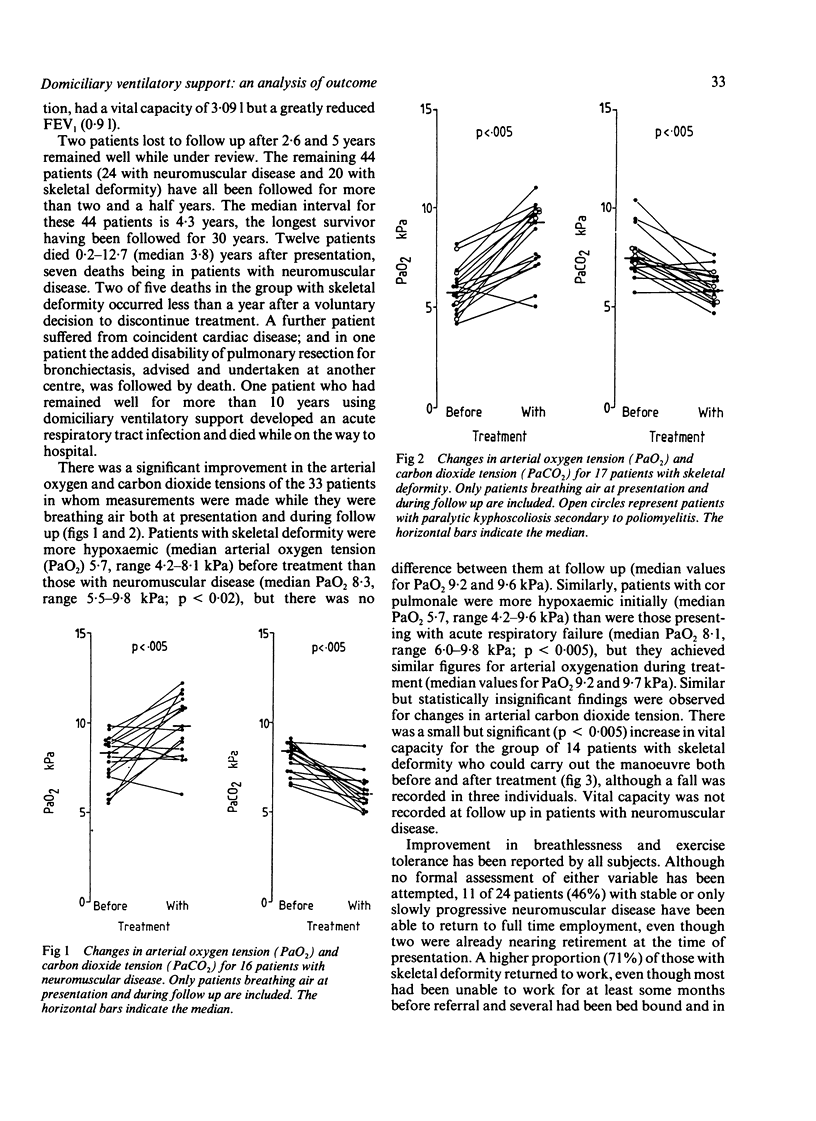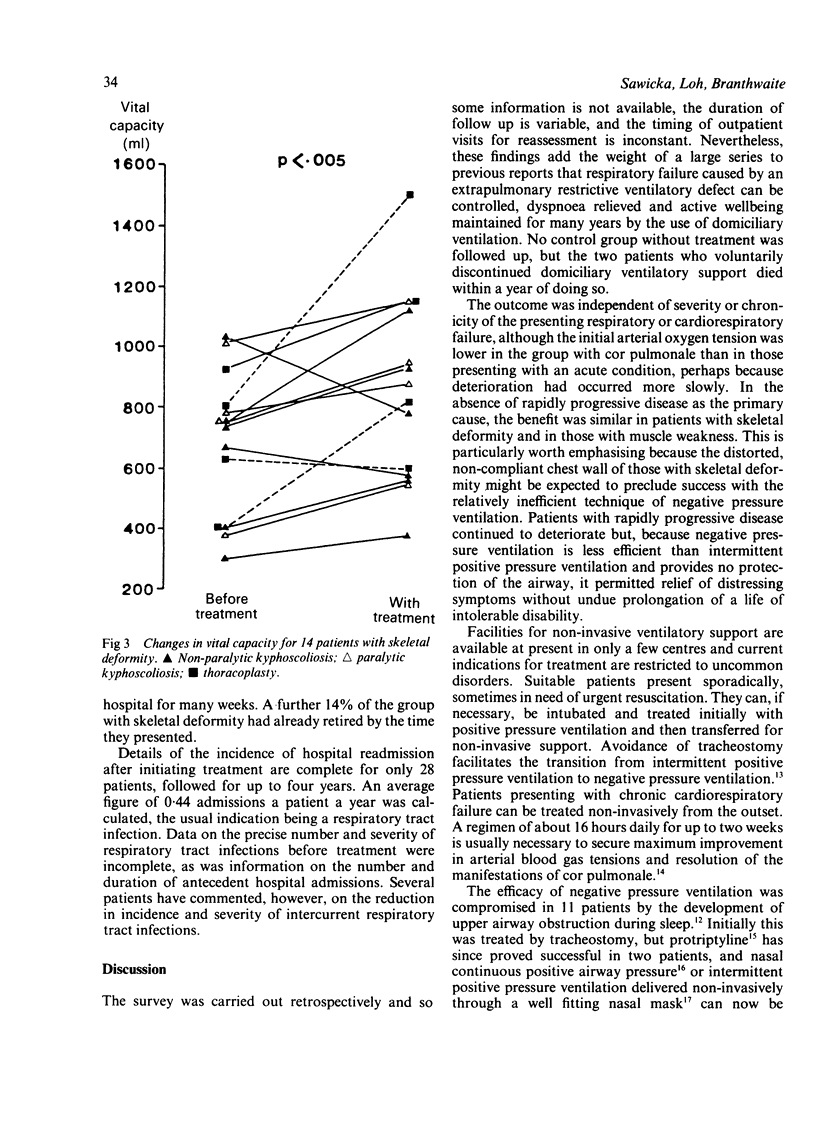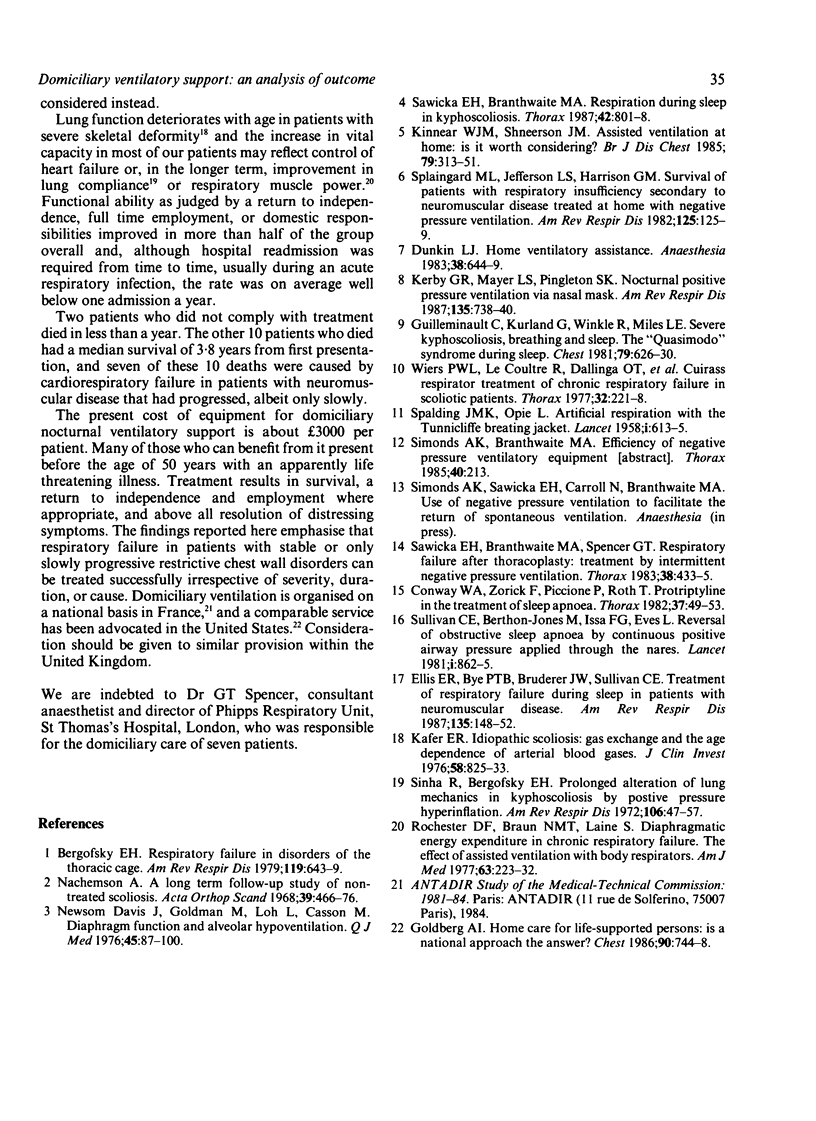Abstract
Prolonged ventilatory support has been used to treat 51 patients with respiratory failure secondary to skeletal (22) or neuromuscular (29) disease. Symptomatic relief was achieved in five patients with rapidly progressive neurological disease who died within 27 months. The remaining 46 patients, aged 11-69 years at presentation, have been followed for more than two and a half years. All but 10 were treated with negative pressure ventilation from the outset, intermittent positive pressure ventilation being used initially in the others and continued at home in three. Nocturnal negative pressure ventilation has been used at home by 39 patients. A permanent tracheostomy has been maintained in 14, to facilitate positive pressure ventilation in three and to circumvent upper airway obstruction during sleep in 11. Sustained improvement in symptoms and arterial blood gas tensions has been maintained, independence and the capacity for gainful employment have been regained in those of an appropriate age, and the incidence of subsequent hospital admissions has been low. Neither the mode of presentation nor the aetiology of the restrictive ventilatory defect influenced outcome in patients with stable or only slowly progressive primary disease.
Full text
PDF




Selected References
These references are in PubMed. This may not be the complete list of references from this article.
- Bergofsky E. H. Respiratory failure in disorders of the thoracic cage. Am Rev Respir Dis. 1979 Apr;119(4):643–669. doi: 10.1164/arrd.1979.119.4.643. [DOI] [PubMed] [Google Scholar]
- Conway W. A., Zorick F., Piccione P., Roth T. Protriptyline in the treatment of sleep apnoea. Thorax. 1982 Jan;37(1):49–53. doi: 10.1136/thx.37.1.49. [DOI] [PMC free article] [PubMed] [Google Scholar]
- Davis J., Goldman M., Loh L., Casson M. Diaphragm function and alveolar hypoventilation. Q J Med. 1976 Jan;45(177):87–100. [PubMed] [Google Scholar]
- Dunkin L. J. Home ventilatory assistance. Anaesthesia. 1983 Jul;38(7):644–649. doi: 10.1111/j.1365-2044.1983.tb12155.x. [DOI] [PubMed] [Google Scholar]
- Ellis E. R., Bye P. T., Bruderer J. W., Sullivan C. E. Treatment of respiratory failure during sleep in patients with neuromuscular disease. Positive-pressure ventilation through a nose mask. Am Rev Respir Dis. 1987 Jan;135(1):148–152. doi: 10.1164/arrd.1987.135.1.148. [DOI] [PubMed] [Google Scholar]
- Goldberg A. I. Home care for life-supported persons. Is a national approach the answer? Chest. 1986 Nov;90(5):744–748. doi: 10.1378/chest.90.5.744. [DOI] [PubMed] [Google Scholar]
- Kafer E. R. Idiopathic scoliosis. Gas exchange and the age dependence of arterial blood gases. J Clin Invest. 1976 Oct;58(4):825–833. doi: 10.1172/JCI108535. [DOI] [PMC free article] [PubMed] [Google Scholar]
- Kerby G. R., Mayer L. S., Pingleton S. K. Nocturnal positive pressure ventilation via nasal mask. Am Rev Respir Dis. 1987 Mar;135(3):738–740. doi: 10.1164/arrd.1987.135.3.738. [DOI] [PubMed] [Google Scholar]
- Kinnear W. J., Shneerson J. M. Assisted ventilation at home: is it worth considering? Br J Dis Chest. 1985 Oct;79(4):313–351. doi: 10.1016/0007-0971(85)90067-1. [DOI] [PubMed] [Google Scholar]
- Nachemson A. A long term follow-up study of non-treated scoliosis. Acta Orthop Scand. 1968;39(4):466–476. doi: 10.3109/17453676808989664. [DOI] [PubMed] [Google Scholar]
- Rochester D. F., Braun N. M., Laine S. Diaphragmatic energy expenditure in chronic respiratory failure. The effect of assisted ventilation with body respirators. Am J Med. 1977 Aug;63(2):223–232. doi: 10.1016/0002-9343(77)90236-4. [DOI] [PubMed] [Google Scholar]
- SPALDING J. M., OPIE L. Artificial respiration with the Tunnicliffe breathing-jacket. Lancet. 1958 Mar 22;1(7021):613–615. doi: 10.1016/s0140-6736(58)90869-9. [DOI] [PubMed] [Google Scholar]
- Sawicka E. H., Branthwaite M. A. Respiration during sleep in kyphoscoliosis. Thorax. 1987 Oct;42(10):801–808. doi: 10.1136/thx.42.10.801. [DOI] [PMC free article] [PubMed] [Google Scholar]
- Sawicka E. H., Branthwaite M. A., Spencer G. T. Respiratory failure after thoracoplasty: treatment by intermittent negative-pressure ventilation. Thorax. 1983 Jun;38(6):433–435. doi: 10.1136/thx.38.6.433. [DOI] [PMC free article] [PubMed] [Google Scholar]
- Sinha R., Bergofsky E. H. Prolonged alteration of lung mechanics in kyphoscoliosis by positive pressure hyperinflation. Am Rev Respir Dis. 1972 Jul;106(1):47–57. doi: 10.1164/arrd.1972.106.1.47. [DOI] [PubMed] [Google Scholar]
- Wiers P. W., Le Coultre R., Dallinga O. T., van Dijl W., Meinesz A. F., Sluiter H. J. Cuirass respirator treatment of chronic respiratory failure in scoliotic patients. Thorax. 1977 Apr;32(2):221–228. doi: 10.1136/thx.32.2.221. [DOI] [PMC free article] [PubMed] [Google Scholar]


